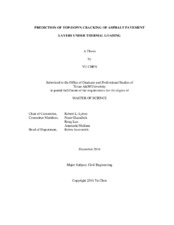| dc.description.abstract | Top-down cracking is a primary fatigue cracking and widespread mode of failure in asphalt concrete pavement. Top-down cracking exists in asphalt pavement layers, initiating at the surface of the pavement and propagating downward through the asphalt layer. This phenomenon of the top-down cracking commonly occurs in the United States and has recently attracted a huge amount of interest from pavement engineers.
Top-down cracking is affected by multiple factors, including pavement materials, pavement structures, heavy traffic, and local climate. The thermal stress caused by low pavement temperature or temperature variation is a critical factor for affecting the top-down cracking in the asphalt pavement layers. The “thermal loading” is regarded as the effect of the thermal stress due to low temperature or result of temperature variation. Weather data are required for the development of the pavement temperature model and further computation of thermal stress. The climate data that contain daily air temperature, daily average wind speed, and hourly solar radiation are collected from the Long-Term Pavement Performance (LTPP) and National Climate Data Center (NCDC) databases. In addition, this pavement temperature model also requires site-specific pavement parameters, including the albedo, emissivity and absorption coefficients, and thermal conductivity for further modeling the viscoelastic thermal stress prediction. The viscoelastic thermal stress model has been developed by the finite difference solution to the viscoelastic constitutive equation based on Boltzmann’s Superposition Principle using the Prony series representation of relaxation modulus. Aging of the asphalt binder is taken into account in this study.
The study develops a mechanistic-empirical approach to predict the top-down cracking under thermal loading in the asphalt pavement layer. This proposed mechanistic-empirical method is based on the modeling of pavement temperature, thermal stress, and thermal cracking. The prediction of top-down cracking in asphalt pavement layer is established by using Paris law and conducted by programming in the C# language. Its fracture coefficients are determined by pavement materials and the stress intensity factor is deduced by results from the viscoelastic thermal stress model. | en |


